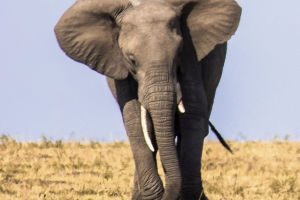Elephants have a rich reproductive history and are one of the oldest and once most dominant groups of animals on Earth.
However, due to the growing human ivory trade, wild elephants are now facing the threat of extinction.
The elephant family has existed on our planet for 50 million years, and as the environment has changed, elephants have evolved to adapt.
Despite being the largest terrestrial animals on the planet, elephants are not immune to the dangers of poaching or the ongoing destruction of their interconnected habitats, which are crucial for their survival.
Over the years, populations of African forest and African savanna elephants have been steadily declining due to the impact of ivory poaching and habitat loss.
The International Union for Conservation of Nature (IUCN) has recognized this by dividing the African elephant into two categories: the critically endangered African forest elephant (CR) and the endangered African savanna elephant(EN).
Previously, the African elephant was considered a single species and was classified as vulnerable. However, the latest research has prompted the IUCN to assess both species separately for the first time.
The extent of the threat to African elephants was previously underestimated due to the misconception that they were a single species.
This recent assessment, which separates savanna and forest elephants, marks the first comprehensive evaluation of their respective statuses.
Genetic studies and the consensus among experts have confirmed that African forests and savanna elephants are distinct species. Forest elephants inhabit the tropical forests of Central and West Africa, with minimal overlap with the range of savanna elephants.
On the other hand, savanna elephants prefer open areas and can be found in various habitats throughout sub-Saharan Africa, including grasslands and deserts.
The natural distribution of forest elephants is more limited, with their current habitat reported to be only a quarter of their historical range.
The largest remaining populations of forest elephants are concentrated in the Gabonese Republic and the Republic of the Congo.
The most recent assessment reveals a concerning decline in African elephant populations across the continent.
Data indicates that African forest elephant populations have plummeted by more than 86% in the past three decades, while African savanna elephant populations have dwindled by at least 60% in the past five decades.
Both species have experienced significant declines in numbers due to the rampant increase in poaching since 2008, which reached its peak in 2011. However, another pressing threat is the alteration of their habitats.
The conversion of natural habitats into agricultural and other land uses poses a substantial risk to the survival of elephants.
According to reliable data from the 2016 IUCN State of the African Elephant Report, the combined continental population of both species is currently estimated to be around 415,000 animals.
Although African elephant species have experienced an overall decline, the assessment highlights the positive influence of conservation efforts.
Ground-level anti-poaching measures, along with legislation and land-use planning focused on promoting human-wildlife coexistence, play a pivotal role in successful elephant conservation.
Some forest elephant populations have already experienced the benefits of these efforts, stabilizing in well-managed protected areas in the Gabonese Republic and the Republic of the Congo.
The savanna elephant populations have also remained stable or even shown signs of growth over the years, particularly in the Kavango Zambezi Transfrontier Conservation Area, which harbors the largest terrestrial subpopulation of savanna elephants.


